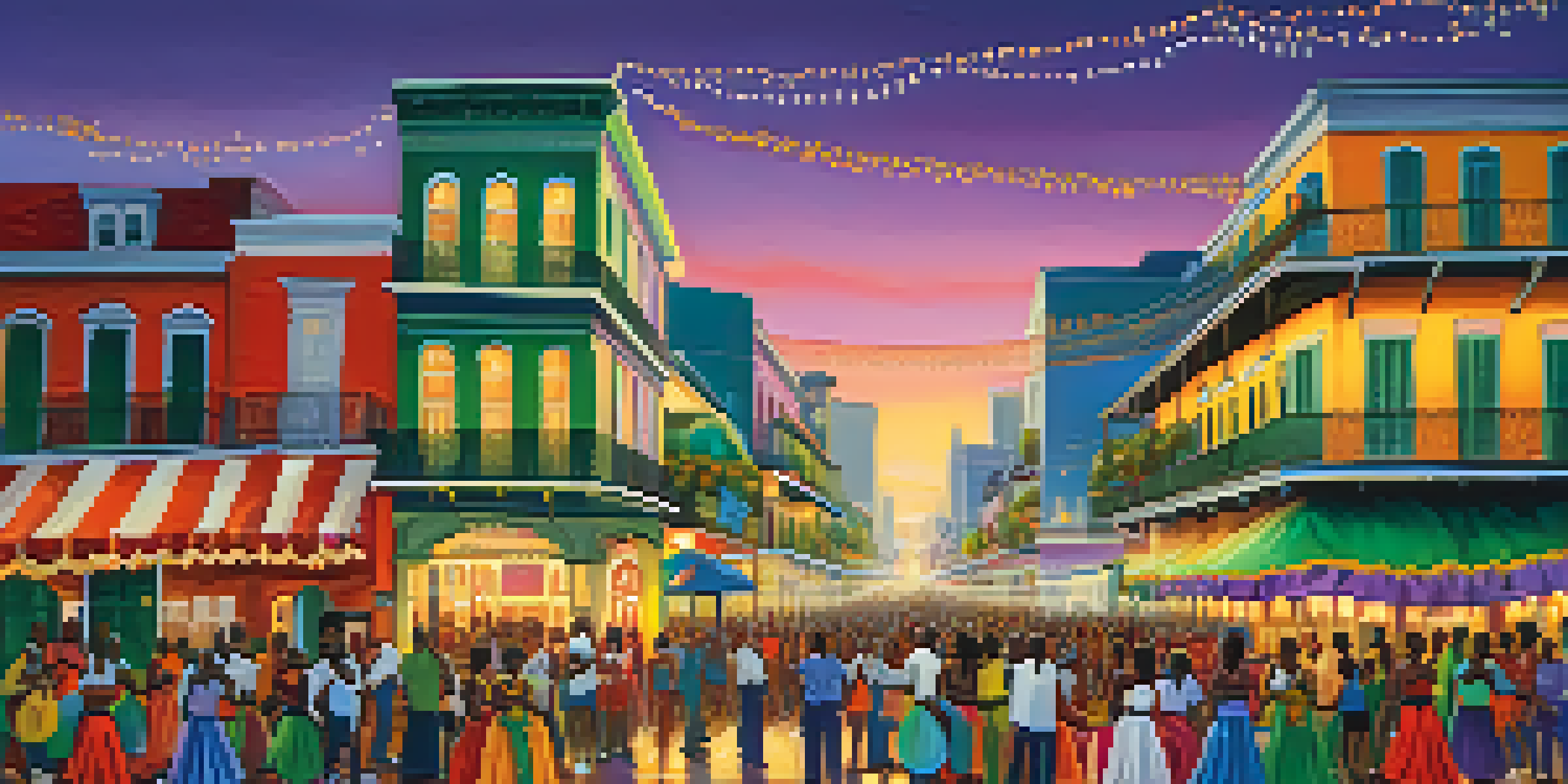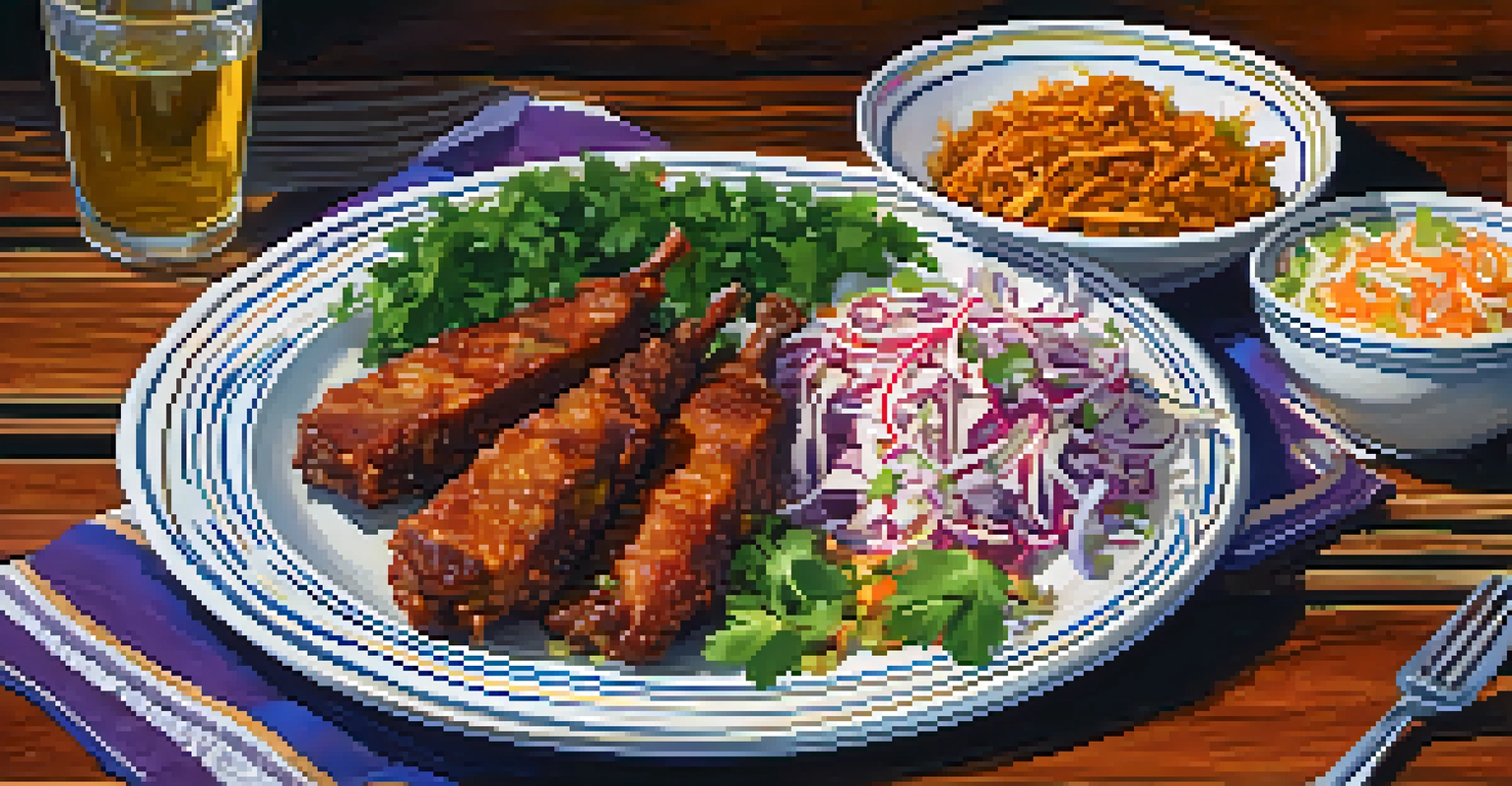The Haitian Impact on New Orleans' Music and Arts Scene

The Historical Ties Between Haiti and New Orleans
The bond between Haiti and New Orleans runs deep, rooted in history and culture. After the Haitian Revolution in the early 19th century, many Haitians sought refuge in New Orleans, bringing their rich traditions with them. This influx not only added to the city’s diverse cultural tapestry but also significantly influenced local music and arts.
Food is our common ground, a universal experience.
Many of these immigrants were skilled artisans, musicians, and performers, introducing unique styles and techniques. The blending of African, French, and Spanish influences with local Creole culture created a vibrant artistic environment. Over time, this fusion helped shape the distinctive sounds and visual arts associated with New Orleans today.
Understanding this historical connection is essential to appreciating the ongoing impact of Haitian culture in the city. The contributions of Haitian immigrants are evident in everything from music genres to culinary delights, making New Orleans a true melting pot of creativity.
Haitian Rhythms and Their Influence on Local Music
Haitian rhythms have made a significant impact on the music scene in New Orleans, particularly in genres like jazz and zydeco. The use of traditional Haitian instruments, such as the conga and the tambour, adds a unique flair to local performances. Musicians often incorporate these rhythms, creating an infectious energy that resonates with audiences.

The relationship between Haitian music and jazz is especially noteworthy, with jazz musicians often drawing inspiration from the syncopated beats found in Haitian songs. This rhythmic complexity not only enriches the music but also reflects the cultural exchange that has occurred over generations. It’s a beautiful example of how different cultures can come together to create something new and exciting.
Haitian Roots in New Orleans Culture
The historical ties between Haiti and New Orleans have enriched the city's cultural landscape, particularly in music, arts, and cuisine.
Moreover, festivals like Mardi Gras serve as platforms where these musical influences shine. The vibrant parades and lively music showcase the seamless blend of Haitian and New Orleans styles, inviting everyone to join in the celebration of life through song and dance.
Visual Arts: The Haitian Influence in New Orleans
The visual arts scene in New Orleans also bears the mark of Haitian influence, showcasing a variety of styles and themes. Many Haitian artists, inspired by their homeland’s landscapes and spirituality, have found a welcoming canvas in the vibrant streets of New Orleans. Their artworks often reflect a blend of cultural motifs, creating pieces that resonate with both locals and visitors alike.
The arts are the most powerful means of communication we have. They allow us to understand one another, to connect across cultures and experiences.
In galleries and public spaces around the city, you can find works that explore themes of identity, community, and resilience. Haitian artists contribute to the rich narrative of New Orleans, using their art as a means of storytelling and cultural preservation. This artistic dialogue fosters a deeper understanding of the shared histories and experiences that shape the city.
Additionally, collaborative projects between Haitian and local artists have emerged, further strengthening these ties. Through workshops and exhibitions, artists are able to share techniques and perspectives, enriching the overall artistic landscape of New Orleans.
Cultural Festivals Celebrating Haitian Heritage
Cultural festivals play a pivotal role in celebrating and promoting Haitian heritage in New Orleans. Events such as the New Orleans Jazz & Heritage Festival often highlight Haitian musicians and artists, showcasing their contributions to the city’s rich tapestry. These festivals not only provide a platform for performance but also foster community engagement and cultural appreciation.
During these celebrations, attendees can immerse themselves in Haitian music, dance, and culinary traditions. From live performances to art displays, festivals bring together diverse communities, creating a sense of unity and shared experience. It's a joyful reminder of how cultural exchange can enrich lives and foster connections.
Vibrant Haitian Influence on Music
Haitian rhythms and instruments have significantly shaped local music genres like jazz and zydeco, creating a dynamic cultural exchange.
Furthermore, these festivals serve as an opportunity for education, allowing the public to learn more about Haiti’s history and culture. Workshops and discussions often accompany the festivities, providing insights into the traditions that have influenced New Orleans’ vibrant arts scene.
Cuisine: The Flavor of Haitian Influence
Haitian cuisine has also made its mark on New Orleans’ culinary scene, adding a burst of flavor to the city's already diverse offerings. Dishes like griot (fried pork) and pikliz (spicy slaw) can be found in restaurants and homes, showcasing the delicious blend of Haitian and Creole flavors. This fusion not only satisfies the palate but also tells a story of cultural exchange and adaptation.
Food festivals and cooking classes often highlight these culinary traditions, allowing chefs to share their heritage with a wider audience. The vibrant spices and cooking techniques from Haiti invite food lovers to explore new tastes and experiences. It’s a culinary adventure that reflects the rich history of both cultures.
Moreover, the communal aspect of sharing meals is a vital part of both Haitian and New Orleans cultures. Gatherings centered around food foster connections among families and communities, reinforcing the bonds that tie them together. It’s a beautiful example of how food can serve as a bridge between cultures.
Modern Collaborations Between Haitian and Local Artists
In recent years, collaborations between Haitian and local New Orleans artists have become more prominent, showcasing the power of creative partnerships. These collaborations often blend different artistic styles, resulting in innovative projects that push the boundaries of traditional art forms. By working together, artists infuse their unique perspectives, creating works that resonate on multiple levels.
One example is the partnership between musicians and visual artists, where live performances are accompanied by dynamic visual displays. This multi-sensory experience captivates audiences, enhancing their appreciation for both music and art. Such collaborations highlight the importance of community and the shared mission of celebrating cultural heritage.
Celebrating Haitian Heritage Together
Cultural festivals in New Orleans highlight Haitian contributions, fostering community engagement and appreciation for shared traditions.
Additionally, these modern collaborations serve as a platform for younger generations to engage with their culture. By bridging the gap between traditional methods and contemporary expressions, artists inspire a new wave of creativity. It’s an exciting time for the arts in New Orleans, as the influence of Haitian culture continues to evolve and flourish.
The Enduring Legacy of Haitian Culture in New Orleans
The legacy of Haitian culture in New Orleans is both profound and enduring, influencing various aspects of life in the city. From music and visual arts to cuisine and festivals, the impact is felt in everyday experiences. This cultural exchange not only enriches the local scene but also strengthens the identities of those who call New Orleans home.
As New Orleans continues to evolve, the contributions of Haitian culture remain a vital part of the narrative. The ongoing celebration of this heritage ensures that future generations will appreciate and carry forward these rich traditions. It’s a testament to the resilience and creativity that define both Haitian and New Orleans cultures.

Ultimately, the Haitian impact on New Orleans serves as a reminder of the beauty of diversity and the importance of cultural exchange. Embracing and celebrating these influences fosters a deeper connection among communities, enriching the lives of everyone involved.